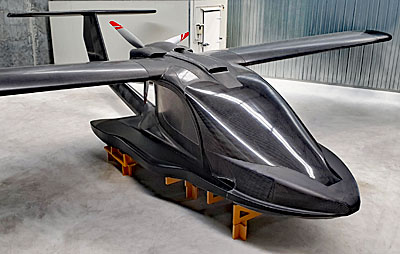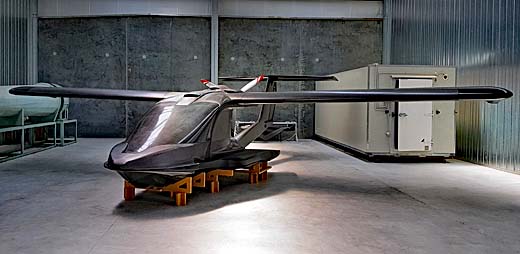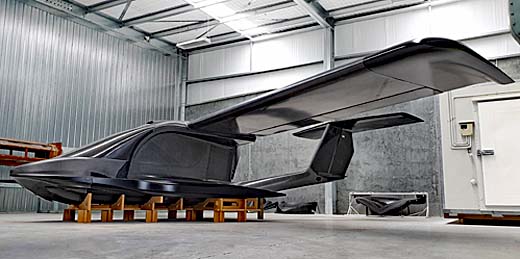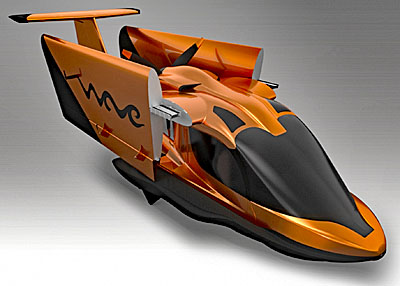It’s big. It’s bold. It’s beautiful. It’s loaded with snazzy custom features. And it’s gonna be powerful.
 You might think those words don’t apply to many Light-Sport Aircraft. Certainly, “big” is not a word most pilots associate with LSA. A number are actually rather compact, though with standardized rules, aircraft parameters don’t differ as much as some might think.
You might think those words don’t apply to many Light-Sport Aircraft. Certainly, “big” is not a word most pilots associate with LSA. A number are actually rather compact, though with standardized rules, aircraft parameters don’t differ as much as some might think.
Wave is different …at least in one particular way. The newest LSA seaplane in development in the Southern Hemisphere has something special. What is it?
Vickers recently announced winning a weight increase exemption for their deluxe Wave. As other producers wait to read FAA’s coming regulation regarding aircraft size, Wave can begin leveraging their higher gross weight to increase capability and power.
Principal Paul Vickers stated, “After many months we can finally announce that Vickers Aircraft has received our FAA weight exemption for the Wave™ LSA. This will allow a MTOW of 1,850 pounds (839 kilograms), so we can incorporate additional safety features that will set the Wave apart and help us achieve our long-term goal of moving aviation forward.” He added, “Some of these safety features include water maneuvering thruster, CrossOver Landing gear, increased horsepower, and the required fuel capacity to ensure the Wave is operated safely and can perform its mission.”
Paul continued, “We have designed the Wave for this increased MTOW and have incorporated the required additional structure.” He feels this sets up Wave to smoothly transition into the LSA rule changes that are on the horizon, new definitions that will include adjustments regarding the weight of Light-Sport Aircraft.
Wave Usability Factor
As Icon moved the price of their deluxe A5 well past the $350,000 mark, the slickly-marketed LSA seaplane made room for a company like Vickers to enter the market.
Icon also won a weight increase, to 1,650 pounds, but A5 is presently placarded at 1,510 pounds, 80 pounds over the standard seaplane/float plane gross of 1,430 pounds. In contrast Wave can weigh 420 pounds more. That’s a lot of extra margin.
 “The aviation industry is known for its high barriers to entry,” said Paul. “While everyone sees the final product (the aircraft) flying, what they don’t see are the years of work that go into the company structure behind it.” Vickers related tasks to meet business regulations plus health and safety requirements, environmental considerations, design, flight and manufacturing criteria as well as aviation authority regulations prior to the first aircraft even operating.
“The aviation industry is known for its high barriers to entry,” said Paul. “While everyone sees the final product (the aircraft) flying, what they don’t see are the years of work that go into the company structure behind it.” Vickers related tasks to meet business regulations plus health and safety requirements, environmental considerations, design, flight and manufacturing criteria as well as aviation authority regulations prior to the first aircraft even operating.
“With this in mind, the last 12 months has seen Vickers not only progress the aircraft design but also move into an employment phase to bring in the necessary people to meet all of our regulatory requirements,” Paul explained. He said this means a doubling of the Engineering (Design) Team numbers and the employment of a Quality and Systems Manager.
Increased staffing levels allowed engineering to move into the stress testing phase of the design program to prove the strength of the design. This phase includes physical coupon testing to demonstrate Vickers can manufacture the parts to the design strengths and to verify our structural analysis. “This phase has to be completed before the flight test aircraft is manufactured to ensure it operates as expected,” Paul noted.

“The benefits to the customer are that our team can quickly retrieve this data both onsite and offsite, immediately understanding the configuration of any aircraft we have built” said Paul. “This provides accurate and fast response times to customers anywhere in the world. There will be no more needing to wait until the office opens in the morning.” That will be valuable as New Zealand operates on a very different time than, for example, the USA.
Civil Aviation Authorities Cooperating
“This period has also seen increased discussions with the Civil Aviation Authority of New Zealand and FAA,” said Paul. “ensuring a common understanding between all three parties of the path to market that the Wave will take. These conversations allow all parties to plan in advance and to remove any surprises that can arise along the way.” Vickers was invited to present on the LSA industry at the recent 21st FAA Asia-Pacific Bilateral Partners Conference.”

This earlier rendering of Wave shows its foldable wings, a benefit to someone wanting to transport the LSA home after flying.
What’s coming next for Wave?
“Our work will be focused on gaining our CAA Manufacturing Certificate,” stated Paul. “We will also obtain CAA approval of our flight test program and continue to build the business structure behind the Wave, to ensure we hit the ground running.”
It’s a common turn of phrase — “hit the ground running” — but more likely seaplane pilots will want to see Wave rising up from the water. Wave has been closely followed by a large number of pilots all over the globe. Vickers said first flight was approaching.
Wave’s price has not been set but Vickers expects to be “competitive.” For an advanced LSA seaplane, that may prove compelling. Oh, and it should be a very powerful LSA, too, but that’s a story for some time in the future..


I hope that part of the added weight will be used to create a crush resistant cockpit with well anchored seats.
On reviewing fatal LSA amphibian crashes, it seems the pilot and passenger hit first and suffer blunt force trauma.
Also, air bags would help when the aircraft is too low for the parachute and has to crash land on ground or water.
Thank you.
I have personally flown the Icon A5 for about ten hours. It’s a fine little airplane but the price tag is way too high. The Vickers Wave has some features on it that make it a game changer (if the price point stays around 200K). First, and most important for safety, it has fixed landing gear. This alone will save many lives from accidental gear down water landings. Second, if the wings can be electrically folded on the water you use the thrusters to dock in a boat slip! How cool is that? Finally, it has a much needed power and useful load increase. This makes the airplane more of a tool than a toy. I am following them closely.
Hi Dan-
I’m confused by what the practical significance of a weight exemption is for someone with a Sport Pilot certificate? By offering an exemption (to the aircraft manufacturer) for the weight limit, does that allow a Sport Pilot to legally fly an aircraft heavier than otherwise specified by the regulations? Is additional training or signoff needed (other than transition training), since all training would have been done in a lighter aircraft?
I’m not a lawyer, but when I look at the plain text of the regs, I don’t see anything that says “If you hold a Sport Pilot certificate you may act as PIC of a heavy LSA aircraft that holds a weight exemption”
-JJ
61 CFR 61.315(a)
If you hold a sport pilot certificate you may act as pilot in command of a light-sport aircraft, except as specified in paragraph (c) of this section.
14 CFR 1.1
Light-sport aircraft means an aircraft, other than a helicopter or powered-lift that, since its original certification, has continued to meet the following:
A maximum takeoff weight of not more than –
1,320 pounds (600 kilograms) for aircraft not intended for operation on water; or
1,430 pounds (650 kilograms) for an aircraft intended for operation on water.
Hi JJ: You asked a great, valid question. First, FAA will be adding “boundaries” for the new regulation that should more squarely address the situation you describe.
However, for today, you asked your last question the wrong way. You’re right that you don’t see “you may act” language but neither do you see “you cannot” words. With the minimum of hours invested, a Sport Pilot certificate will not clear you to fly a LSA seaplane with retractable gear (although Vickers has their own unique system), however, with further instruction and a mere instructor entry in your logbook, you can go forward …much like you cannot enter Class B airspace without further instruction but with such and a logbook endorsement, a qualified pilot may do so.
So, to fly a heavier-than-most-LSA Vickers Wave you will surely require more instruction but the current regulation says nothing that I see to prevent a trained pilot from operating a Wave.
Hi JJ,
The nature of exemptions is to do something outside of the plain text of the regulations. Here is part of what the FAA wrote in response to Vickers’ petition application:
The FAA’s Decision:
In consideration of the foregoing, I find that a grant of exemption is in the public interest. Therefore, under the authority provided by 49 U.S.C. § 106(f), 40113, and 44701, which the FAA Administrator has delegated to me, Vickers is granted an exemption from 14 CFR §§ 21.181(a)(3)(i) and 21.190(a) to the extent necessary to allow the Vickers Wave aircraft with a MTOW of 1850 pounds to be eligible for issuance of a special airworthiness certificate in the light-sport category. Vickers is also granted an exemption from 14 CFR §§ 61.89(c)(1), 61.303(a), and 61.315(a) on behalf of persons exercising the privileges of a sport pilot certificate or student pilots seeking a sport pilot certificate to permit those persons to operate the Vickers Wave and to permit flight time obtained in the Vickers Wave to be considered flight time obtained in a light-sport aircraft. Vickers is also granted an exemption from 14 CFR §§ 61.411(a), 61.415(a), and 61.429(b) on behalf of persons exercising the privileges of a flight instructor certificate with a sport pilot rating to permit those persons to provide flight training in the Vickers Wave. Additionally, Vickers is granted an exemption from 14 CFR §§ 43.3(c), 43.7(g) and 65.107(b) and (c) on behalf of holders of sport pilot certificates and repairman certificates (light-sport aircraft) with a maintenance rating or an inspection rating to permit those persons to perform maintenance and preventive maintenance on Vickers Wave aircraft as authorized within those sections. All of these grants are subject to the conditions and limitations listed below.
I hope that helps!
On that topic, any word on the MVP Aero?
I thought both the Vickers and the MVP were dead projects by now, but apparently there’s something going on with Vickers, so I am wondering if MVP Aero is still alive as well…
Hi Rafael: While Vickers reports being alive and well, sadly, the same is not true for the ambitious MVP project. Challenges in fundraising appear to have scuttled the effort though a new investor could revive it, I’m sure.
Sure looks a lot like an Icon A5. Will be interesting to see the actual out the door price point, eh?
Hi Ric: Yes, as noted to another reader/commenter, Wave exhibits similarities to A5 but that may only be skin-deep. Vickers Aircraft notes a much lower part count and that suggests quite different manufacturing practices. Regarding price, they have not updated their projected price tag, but I would expect it to exceed $200,000. That’s beyond the budget of many, I know, but is not far above far similar seaplanes and is far less than A5. (Aero Adventure‘s kit seaplanes are much less costly for those with thinner wallets. ••• Progressive Aerodyne‘s well-proven Searey is also more affordable.) All seaplanes or float planes have a significant price premium over land plane equivalents.
Almost a perfect copy of an Icon-A5….
Hello Not Impressed: Wave does appear similar to A5 but under the skin it is quite different. Vickers said their part count is much lower and that should make it easier (less costly?) to manufacture. Other differences may also surface after people can inspect the first article aircraft.